Photovoltaic Evaporative Chimney I–V Measurement System
Abstract
:1. Introduction, Background, and Objectives
1.1. Introduction
1.2. Background: The Photovoltaic Evaporative Chimney
1.3. Objectives
2. Materials and Methods
2.1. Experimental Facility: The Evaporative Photovoltaic Chimney
2.2. Experimental Procedure
2.3. I–V Measurement System Design
- (1)
- Variable Resistance. The simplest way to measure the I–V curve is by using a variable resistor connected directly to the panel. The value of the resistor is increased in small steps from zero to open circuit, measuring the current and voltage provided by the panel in each step. These variations can be carried out manually [21], making the process very slow or automated [22,23] (for example connecting different resistors in parallel and using switches controlled by a computer and automating the measurements). This method is only valid for low-power installations, because during the measurement all the generated power by the PV modules are dissipated in the resistors.
- (2)
- Electronic Load. The electronic load method is based on using a transistor as a variable load connected to the panel [24,25,26,27]. To sweep the curve, the transistor works in the three possible modes of operation (on, linear zone, and off), controlled by the voltage applied to the gate. The great advantage of this method, with respect to the variable resistance, is its simpler control and the fast and accurate variation of the transistor equivalent resistance. This method can only be used for medium/low power measurements, as the transistor must be able to dissipate all the power supplied by the photovoltaic installation.
- (3)
- DC–DC Converter. The DC–DC converter’s ability to emulate a resistor has been used in many applications. This ability can also be applied to obtain the I–V curves in PV applications [28]. The value of the emulated resistance can be varied by modifying the converter duty cycle; therefore, if a duty cycle sweep is performed, a characteristic curve sweep will also be performed. Buck–boost-type converters and their variations (SEPIC and Cûk) are the only ones that allow a complete sweep of the curve. Buck-type converters do not allow the curve to be captured near the short-circuit point, and Boost-type ones do not allow capture of the open-circuit point. The main problem with this methodology is the current/voltage ripple caused by the commutations, which makes it difficult to accurately measure the curve.
- (4)
- Capacitive Load. This measurement method is based on connecting the PV modules to a high-capacity discharged capacitor. The capacitor will charge from zero volts up to the module open-circuit voltage of the panel, sweeping the entire characteristic curve [23,29]. The capacitance needed depends on the speed of the measurement equipment, the short-circuit current, and the open-circuit voltage of the modules.
2.3.1. Power Electronics Circuit
2.3.2. Measurement Circuit
2.3.3. Control Circuit
3. Results and Discussion
3.1. I–V Curves
3.2. Influence of the Evaporative Chimney on the I–V Curves
4. Conclusions
- The modules bypass diodes are not activated during the experimental tests despite the temperature stratification that appears in the PV modules. Therefore, the MPPT of the grid-tied inverter is not compromised.
- The photovoltaic chimney system improves the efficiency of the panels. For a typical case, the short-circuit current is slightly reduced, while the open-circuit voltage increases from 32.40 V to 34.49 V. As a result, there is an increase of the maximum power generated by the module, typically from 180 W to 200 W (10% increase).
- The power generation slightly increases with the level of solar irradiance for the same ambient temperature. The improvement of power generation remains fairly constant between the cases where the chimney is activated and deactivated.
Future Works
- Analyzing the influence of the operating conditions (i.e., water flow rate sprayed by the nozzles, number of chimneys activated, heat load, etc.) on the system performance.
- Implementing other active cooling techniques to achieve the temperature reduction of the panels (i.e., water sliding onto the front surface of the panels (Lucas et al. [31]).
- Conducting a thorough economic analysis of the system, including all the costs and taking into account the integration between the electrical energy demand of the heat pump and the PV energy generation hourly profiles. The study can be extended to different climatic conditions (e.g., Mediterranean climates).
Author Contributions
Funding
Conflicts of Interest
Abbreviations
| Symbols | |
| I | current (A) |
| P | power (W) |
| V | voltage (V) |
| Abbreviations | |
| PV | photovoltaic |
References
- IEA. The Future of Cooling: Opportunities for Energy-Efficient Air Conditioning; Annual Report; IEA: Paris, France, 2018.
- Kim, D.; Ferreira, C.I. Solar refrigeration options—A state-of-the-art review. Int. J. Refrig. 2008, 31, 3–15. [Google Scholar] [CrossRef]
- Ghafoor, A.; Munir, A. Worldwide overview of solar thermal cooling technologies. Renew. Sustain. Energy Rev. 2015, 43, 763–774. [Google Scholar] [CrossRef]
- Fong, K.; Chow, T.; Lee, C.; Lin, Z.; Chan, L. Comparative study of different solar cooling systems for buildings in subtropical city. Sol. Energy 2010, 84, 227–244. [Google Scholar] [CrossRef]
- Otanicar, T.; Taylor, R.A.; Phelan, P.E. Prospects for solar cooling—An economic and environmental assessment. Sol. Energy 2012, 86, 1287–1299. [Google Scholar] [CrossRef]
- Hartmann, N.; Glueck, C.; Schmidt, F. Solar cooling for small office buildings: Comparison of solar thermal and photovoltaic options for two different European climates. Renew. Energy 2011, 36, 1329–1338. [Google Scholar] [CrossRef]
- Lazzarin, R.M. Solar cooling: PV or thermal? A thermodynamic and economical analysis. Int. J. Refrig. 2014, 39, 38–47. [Google Scholar] [CrossRef]
- Lazzarin, R.; Noro, M. Past, present, future of solar cooling: Technical and economical considerations. Sol. Energy 2018, 172, 2–13. [Google Scholar] [CrossRef]
- Mugnier, D.; Fedrizzi, R.; Thygesen, R.; Selke, T. New Generation Solar Cooling and Heating Systems with IEA SHC Task 53: Overview and First Results. Energy Procedia 2015, 70, 470–473. [Google Scholar] [CrossRef] [Green Version]
- Al-Alili, A.; Hwang, Y.; Radermacher, R. Review of solar thermal air conditioning technologies. Int. J. Refrig. 2014, 39, 4–22. [Google Scholar] [CrossRef]
- Biwole, P.H.; Eclache, P.; Kuznik, F. Phase-change materials to improve solar panel’s performance. Energy Build. 2013, 62, 59–67. [Google Scholar] [CrossRef] [Green Version]
- Chandrasekar, M.; Rajkumar, S.; Valavan, D. A review on the thermal regulation techniques for non integrated flat PV modules mounted on building top. Energy Build. 2015, 86, 692–697. [Google Scholar] [CrossRef]
- Odeh, S.; Behnia, M. Improving Photovoltaic Module Efficiency Using Water Cooling. Heat Transf. Eng. 2009, 30, 499–505. [Google Scholar] [CrossRef]
- Teo, H.; Lee, P.; Hawlader, M. An active cooling system for photovoltaic modules. Appl. Energy 2012, 90, 309–315. [Google Scholar] [CrossRef]
- Bahaidarah, H.; Subhan, A.; Gandhidasan, P.; Rehman, S. Performance evaluation of a PV (photovoltaic) module by back surface water cooling for hot climatic conditions. Energy 2013, 59, 445–453. [Google Scholar] [CrossRef]
- Kaiser, A.; Zamora, B.; Mazón, R.; García, J.; Vera, F. Experimental study of cooling BIPV modules by forced convection in the air channel. Appl. Energy 2014, 135, 88–97. [Google Scholar] [CrossRef]
- Chandel, S.; Agarwal, T. Review of cooling techniques using phase change materials for enhancing efficiency of photovoltaic power systems. Renew. Sustain. Energy Rev. 2017, 73, 1342–1351. [Google Scholar] [CrossRef]
- Lucas, M.; Aguilar, F.; Ruiz, J.; Cutillas, C.; Kaiser, A.; Vicente, P. Photovoltaic Evaporative Chimney as a new alternative to enhance solar cooling. Renew. Energy 2017, 111, 26–37. [Google Scholar] [CrossRef]
- Vieira, R.G.; de Araújo, F.M.U.; Dhimish, M.; Guerra, M.I.S. A Comprehensive Review on Bypass Diode Application on Photovoltaic Modules. Energies 2020, 13, 2472. [Google Scholar] [CrossRef]
- Ruiz, J.; Martínez, P.; Sadafi, H.; Aguilar, F.; Vicente, P.; Lucas, M. Experimental characterization of a photovoltaic solar-driven cooling system based on an evaporative chimney. Renew. Energy 2020, 161, 43–54. [Google Scholar] [CrossRef]
- Van Dyk, E.; Gxasheka, A.; Meyer, E. Monitoring current-voltage characteristics of photovoltaic modules. In Proceedings of the Conference Record of the Twenty-Ninth IEEE Photovoltaic Specialists Conference, New Orleans, LA, USA, 19–24 May 2002; pp. 1516–1519. [Google Scholar] [CrossRef]
- Van Dyk, E.; Gxasheka, A.; Meyer, E. Monitoring current–voltage characteristics and energy output of silicon photovoltaic modules. Renew. Energy 2005, 30, 399–411. [Google Scholar] [CrossRef]
- Recart, F.; Mackel, H.; Cuevas, A.; Sinton, R. Simple Data Acquisition of the Current-Voltage and Illumination-Voltage Curves of Solar Cells1. In Proceedings of the 2006 IEEE 4th World Conference on Photovoltaic Energy Conference, Waikoloa, HI, USA, 7–12 May 2006; Volume 1, pp. 1215–1218. [Google Scholar] [CrossRef]
- Kuai, Y.; Yuvarajan, S. An electronic load for testing photovoltaic panels. J. Power Sources 2006, 154, 308–313. [Google Scholar] [CrossRef]
- Forero, N.; Hernández, J.; Gordillo, G. Development of a monitoring system for a PV solar plant. Energy Convers. Manag. 2006, 47, 2329–2336. [Google Scholar] [CrossRef]
- Salmon, J.; Phelps, R.; Michael, S.; Loomis, H. Solar Cell Measurement System for NPS Spacecraft Architecture and Technology Demonstration Satellite, NPSAT1. 2003. Available online: https://www.edn.com/power-mosfet-is-core-of-regulated-dc-electronic-load/ (accessed on 1 February 2021).
- Garrigós, A.; Blanes, J. Power Mosfet Is Core of Regulated DC Load. 2005. Available online: http://hdl.handle.net/10945/30341 (accessed on 1 February 2021).
- Aranda, E.D.; Gomez Galan, J.A.; de Cardona, M.S.; Andujar Marquez, J.M. Measuring the I–V curve of PV generators. IEEE Ind. Electron. Mag. 2009, 3, 4–14. [Google Scholar] [CrossRef]
- Muñoz, J.; Lorenzo, E. Capacitive load based on IGBTs for on-site characterization of PV arrays. Sol. Energy 2006, 80, 1489–1497. [Google Scholar] [CrossRef] [Green Version]
- ISO. Evaluation of Measurement Data. Guide to the Expression of Uncertainty in Measurement; ISO: Geneva, Switzerland, 2008. [Google Scholar]
- Lucas, M.; Ruiz, J.; Aguilar, F.; Cutillas, C.; Kaiser, A.; Vicente, P. Experimental study of a modified evaporative photovoltaic chimney including water sliding. Renew. Energy 2019, 134, 161–168. [Google Scholar] [CrossRef]



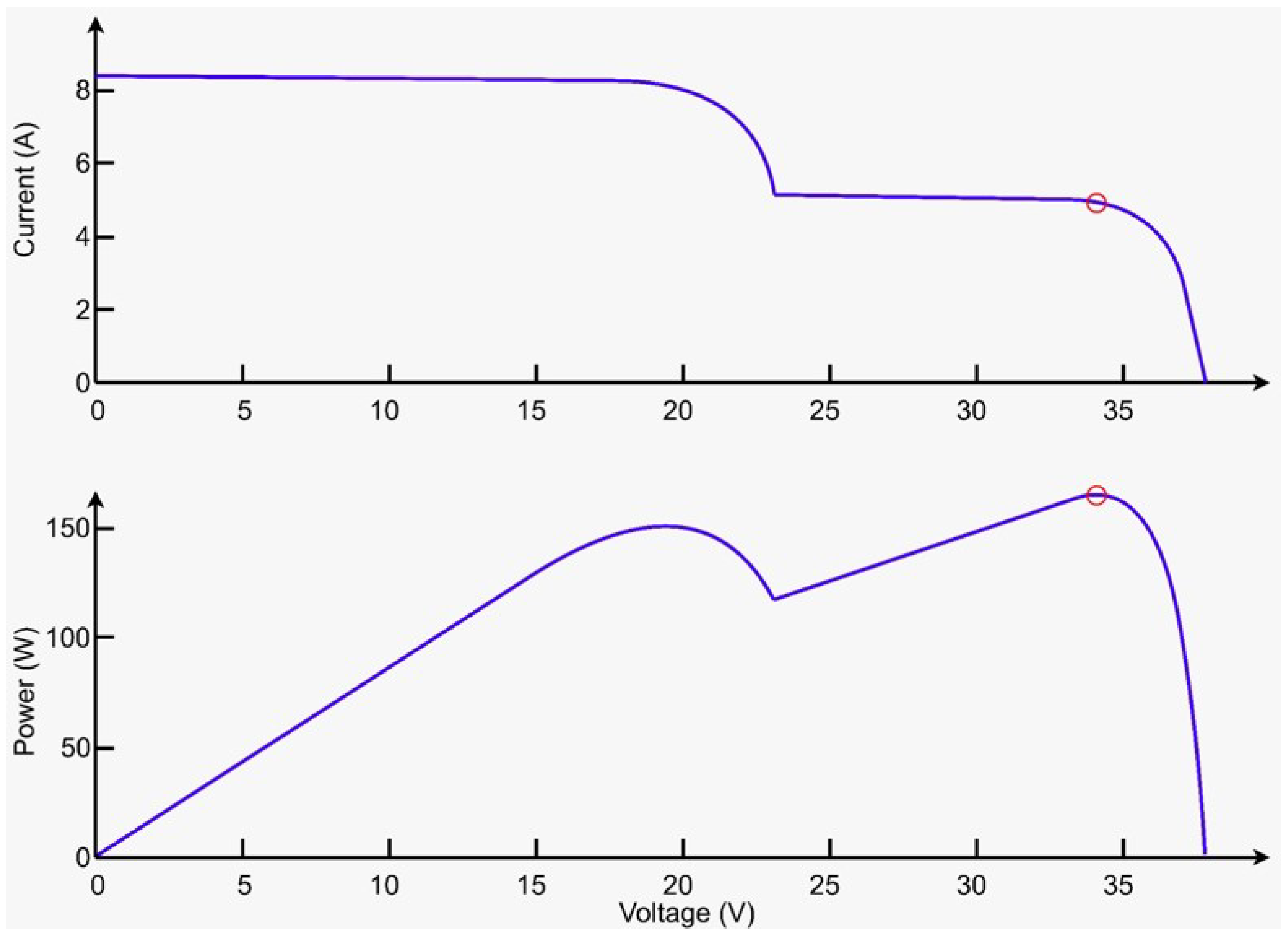
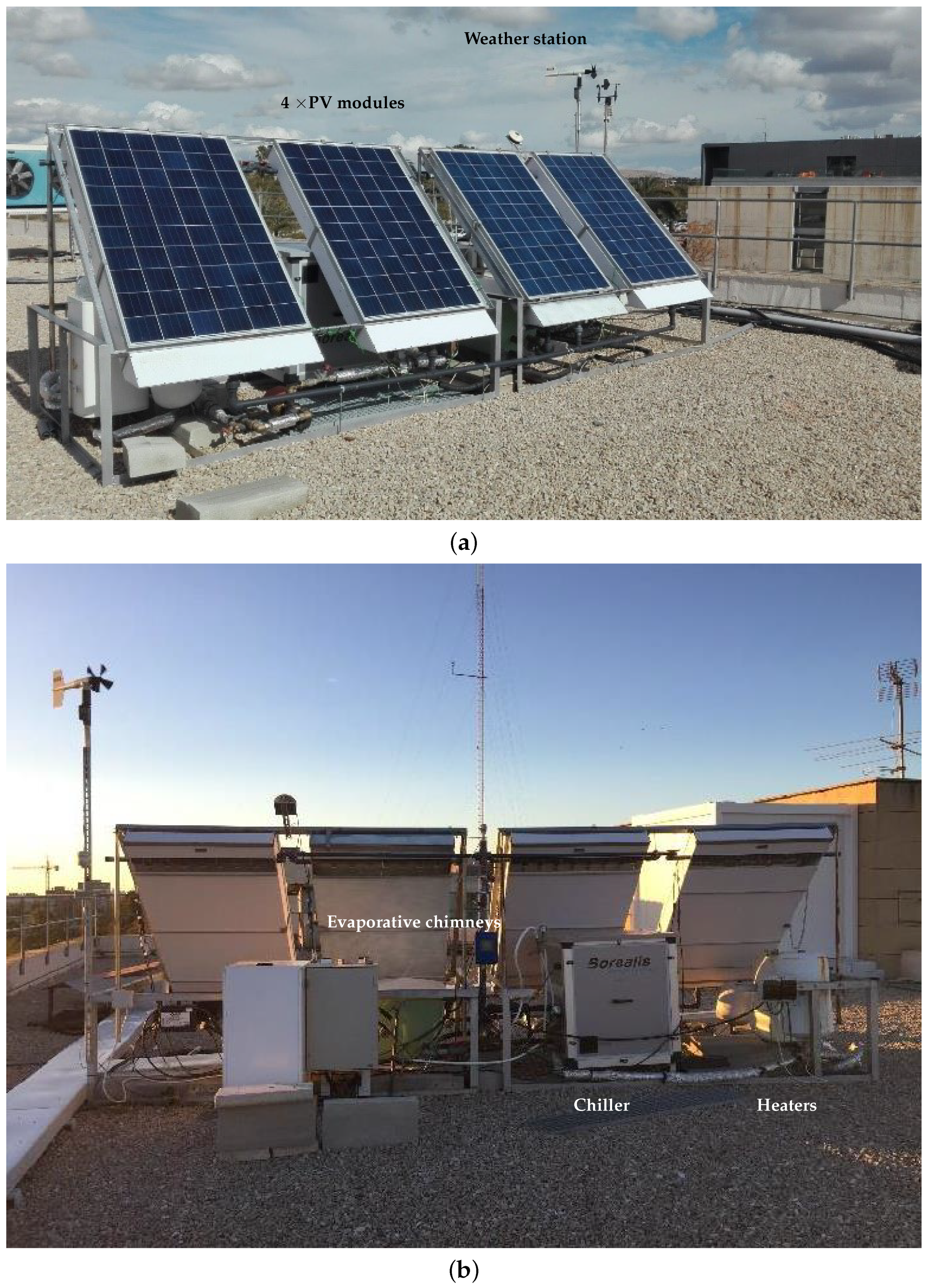
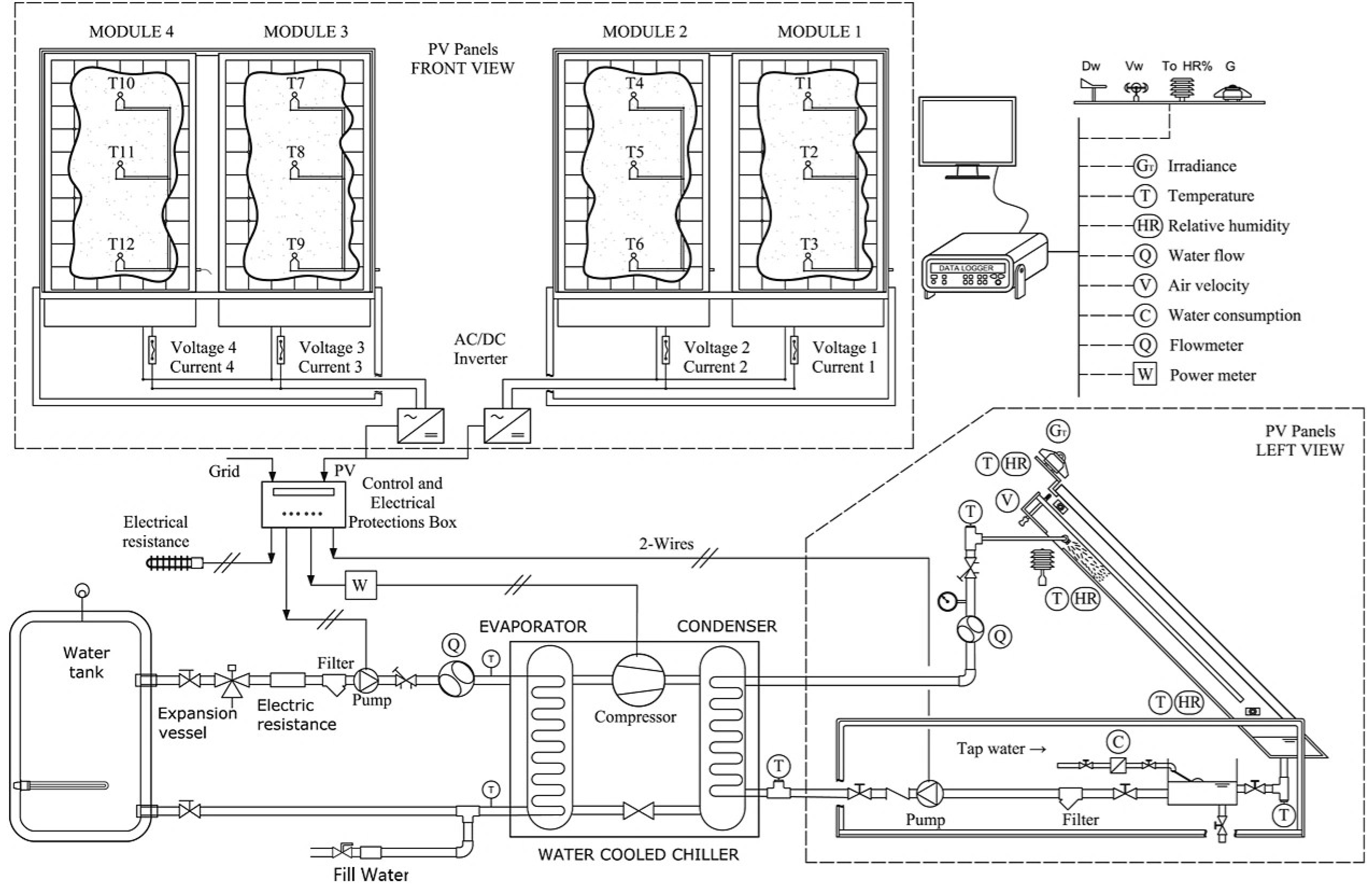



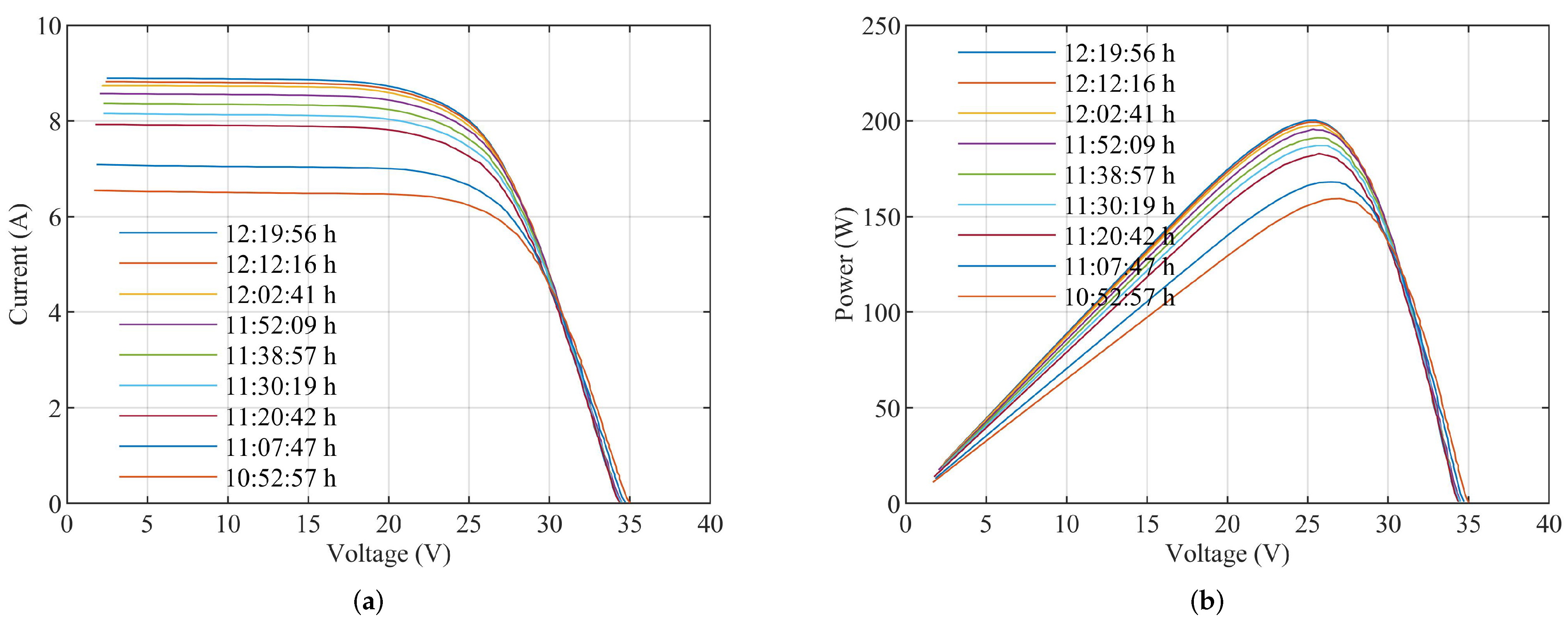

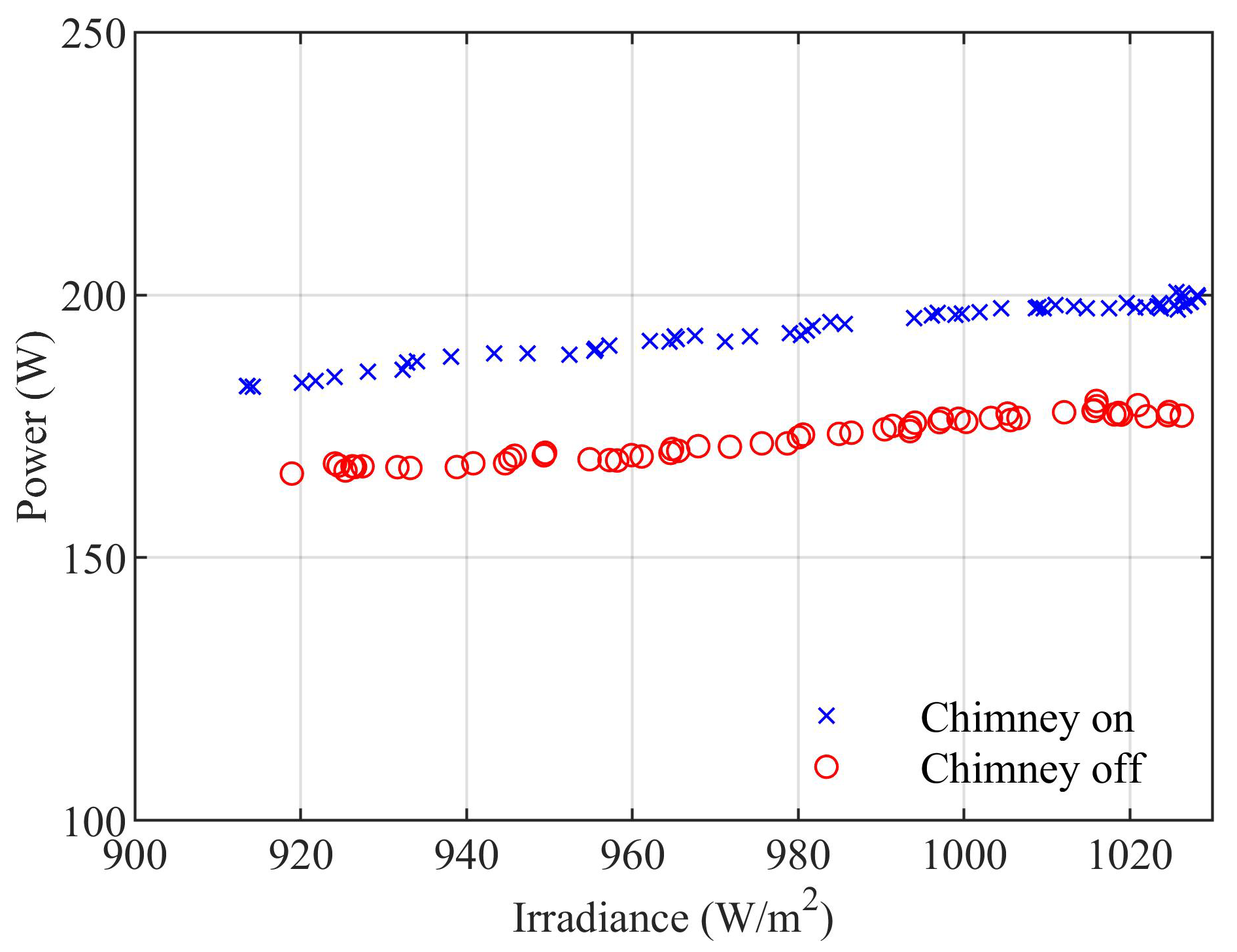
| Magnitude | Units | Value |
|---|---|---|
| Maximum power | W | 255 |
| Dimensions | mm | 1637 × 992 × 40 |
| Number of cells | - | 60 |
| Number of diodes | - | 6 |
| Cell type | - | Polycrystalline |
| Module efficiency | % | 15.7 |
| Short-circuit current | A | 9.11 |
| Open-circuit voltage | V | 37.49 |
| Nominal voltage | V | 30.24 |
| Nominal current | A | 8.44 |
| Variable | Brand-Model | Sensor Type | Range | Accuracy |
|---|---|---|---|---|
| Ambient air temperature | E+E Elektronik (EE 21) | Capacitive sensor | −20–80 °C | ±0.3 °C |
| Ambient air relative humidity | E+E Elektronik (EE 21) | Capacitive sensor | 0–100% | % |
| Wind direction | Young (05103L) | Balanced vane | 0–360° | |
| Wind speed | Young (05103L) | 4-blade helicoid propeller | 0–50 m/s | m/s |
| Irradiance | Kipp&Zonen CM-6B | First-class pyranometer | 0–1400 W/m | % RD |
Publisher’s Note: MDPI stays neutral with regard to jurisdictional claims in published maps and institutional affiliations. |
© 2021 by the authors. Licensee MDPI, Basel, Switzerland. This article is an open access article distributed under the terms and conditions of the Creative Commons Attribution (CC BY) license (https://creativecommons.org/licenses/by/4.0/).
Share and Cite
Casado, P.; Blanes, J.M.; Valero, F.J.A.; Torres, C.; Lucas Miralles, M.; Ruiz Ramírez, J. Photovoltaic Evaporative Chimney I–V Measurement System. Energies 2021, 14, 8198. https://doi.org/10.3390/en14248198
Casado P, Blanes JM, Valero FJA, Torres C, Lucas Miralles M, Ruiz Ramírez J. Photovoltaic Evaporative Chimney I–V Measurement System. Energies. 2021; 14(24):8198. https://doi.org/10.3390/en14248198
Chicago/Turabian StyleCasado, Pablo, José M. Blanes, Francisco Javier Aguilar Valero, Cristian Torres, Manuel Lucas Miralles, and Javier Ruiz Ramírez. 2021. "Photovoltaic Evaporative Chimney I–V Measurement System" Energies 14, no. 24: 8198. https://doi.org/10.3390/en14248198







